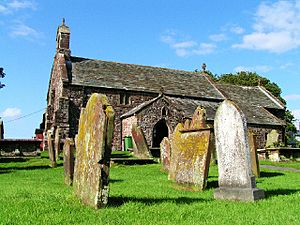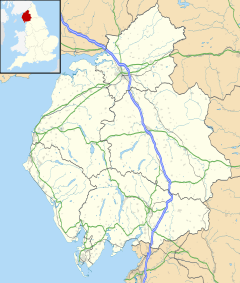Crosscanonby facts for kids
Quick facts for kids Crosscanonby |
|
|---|---|
 St John the Evangelist's Church, Crosscanonby |
|
| Population | 1,054 (2001) |
| OS grid reference | NY0690139075 |
| • London | 259 miles (417 km) SE |
| Civil parish |
|
| Unitary authority |
|
| Ceremonial county | |
| Region | |
| Country | England |
| Sovereign state | United Kingdom |
| Post town | Maryport |
| Postcode district | CA15 |
| Dialling code | 01900 |
| Police | Cumbria |
| Fire | Cumbria |
| Ambulance | North West |
| EU Parliament | North West England |
| UK Parliament |
|
Crosscanonby (also known as Cross Canonby) is a small village in Cumbria, England. It's located near the famous Lake District National Park. The village is also part of the beautiful Solway Coast, which is a special area known for its natural beauty.
The area around Crosscanonby, called its civil parish, includes the larger village of Crosby. It also has smaller areas called Birkby and Crosby Villa. In 2011, about 1,113 people lived in the parish. The main village of Crosby has a local pub called the Stag Inn and a primary school.
Contents
What's in a Name? The Story of Crosscanonby
The name 'Crosscanonby' has a cool history! It first appeared around 1123-1150 as 'Crosseby'. This name comes from an old Norse phrase, "'krossa býr'". It means 'village marked by crosses'. The 'Canonby' part was added later. This happened because land in Crosby, including the church, was given to the canons (priests) of Carlisle.
Where is Crosscanonby Located?
Crosscanonby is very close to the coast of Cumbria, less than 1 kilometre (about 0.6 miles) from the sea. It sits just north of the River Ellen. The village is also near the southern end of Allonby Bay, which is part of the Solway Firth.
This is where you'll find the old Norman church, St John the Evangelist's Church, Crosscanonby. You can also visit the Crosscanonby Carr nature reserve here. North of the village, you'll discover the historic salt pans. These were places where salt was made from seawater a long time ago, from the 1630s until about 1760. Some old cottages in the village were built for the salt workers. These cottages later became a pub, then turned back into homes around 1900. The coastal road, B5300, was built in 1824 and runs right past the salt pans and these old cottages.
Crosscanonby is about 37 kilometres (23 miles) southwest of Carlisle. It's also about 14 kilometres (8.8 miles) south of Silloth and less than 3.2 kilometres (2 miles) northeast of Maryport.
How Crosscanonby is Governed
Crosscanonby is part of the Penrith and Solway area for the UK Parliament. This is where people vote for their MP.
For local matters, Crosscanonby is part of the Cumberland local council area. It also has its own local group called the Crosscanonby Parish Council. This council helps make decisions for the village and its surrounding area.
Crosscanonby's Historic Church
The village is home to St John the Evangelist's Church, Crosscanonby. This church is a very old building, built around 1130 AD. It's considered a 'grade I listed building', which means it's very important historically. The church stands on one of the oldest Christian sites in Cumbria. It has been repaired and updated many times since 1880. You can even see a Viking-era gravestone near the church wall! Some of the stones used to build the church might have come from even older Roman buildings in the area. Outside the church, there's a unique tomb for a local salt tax officer named John Smith, who died in 1730. His tomb has a carving of him working at his desk.
Crosscanonby Carr: A Nature Spot
Crosscanonby Carr is a special nature reserve. It was the first of its kind in the Solway Plain Area of Outstanding Natural Beauty. This place used to be a damaged site, but it was turned into a wonderful refuge. Now, Crosscanonby Carr has wetlands, meadows, and woodlands. It's a home for many different animals, birds, and plants. There's even a special path called the 'Access for All Trail' so that people with all kinds of disabilities can enjoy the site.
Learning in Crosscanonby
The parish has one local primary school, called Crosscanonby St John's Church of England School. It's located in the village of Crosby. About 66 students, aged 4 to 11, attend this school.
A Glimpse into Crosscanonby's Past

North of the village, along the coast, you can find the remains of a Roman fortlet called Milefortlet 21. This fortlet is part of the famous Hadrian's Wall World Heritage Site. It was built between 79 AD and about 130 AD. It tells us a lot about what life was like for Roman soldiers in Britain. Milefortlet 21 was part of a big defense system, including Hadrian's Wall, built to protect this far corner of the Roman Empire. Another Roman fortlet, Milefortlet 22, is west of the village, but it's now hidden under the Maryport Golf Course.
Near Milefortlet 21, you can also see the remains of old salt pans. These were used to make salt from seawater. People think they started around 1630. Seawater would flow from a tank on the beach into a large pond called a 'Kinch'. This pond was sealed with clay. The strong salty water (brine) from the Kinch would then trickle down to be boiled in iron pans. As the water boiled away, salt would form crystals.
In 1698, a tax was put on salt. John Smith, whose tombstone is at St John the Evangelist's Church, Crosscanonby, was one of these salt tax officers. His tombstone even shows him working at his desk!
After salt production stopped, the salt pans found a new use in the 20th century. Between 1918 and the 1930s, holiday cottages and a caravan site grew up around them. They became a tourist attraction. However, the caravan site was abandoned in the 1970s because the coast was eroding.
In the mid-1980s, people realized how important these salt pans were historically. Work began to protect them. Between 1997 and 1998, major efforts were made to save the salt pans from Coastal erosion. A wooden fence was built, and over 2,000 tonnes of material from the nearby Crosscanonby Carr nature reserve were used to protect the site. Today, the salt pans are still there, but they are always at risk from the tides.
Crosscanonby's Population Over Time
The first record of Crosscanonby's population was in 1801, when 3,252 people lived there. The population grew a lot over the next 50 years, almost doubling to 6,182 by 1851. It reached its highest point in 1891 with 9,196 people. However, ten years later, in 1901, the population dropped quite a bit to 931 people. Since then, the population has changed a few times, reaching 1,054 people in 2001.


